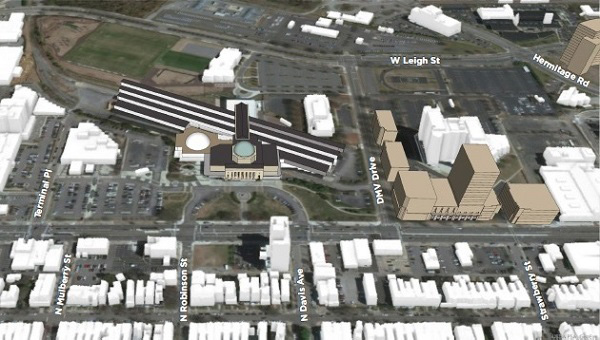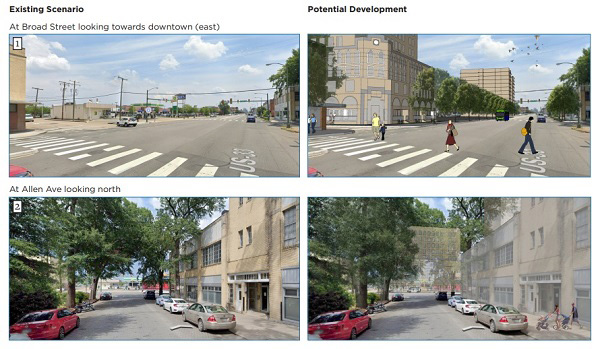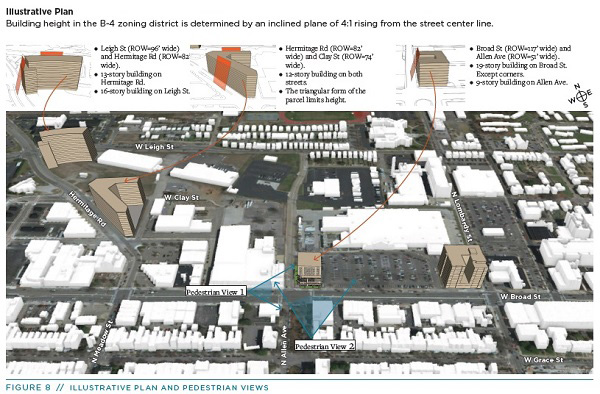
Renderings show potential building heights along Broad Street and Hermitage Road near the Science Museum of Virginia based on the city’s Pulse Corridor Plan. (Images courtesy of the city of Richmond)
Just days before it was to go to the City Council for a vote, the latest round of proposed zoning changes tied to the city’s Pulse Corridor Plan has been withdrawn following months of opposition from neighborhood groups.
A city spokesman confirmed this week that administrators have pulled the proposal, which focused on land primarily north of Broad Street across from the Fan District, in and around the Carver and Newtowne West neighborhoods generally between Belvidere Street and the DMV headquarters building.
The council had been scheduled to consider the rezonings at its meeting this coming Monday, following multiple delays and deferrals since the changes were first proposed in May.
But with opposition remaining from a group of area neighborhood and civic associations, administrators decided to withdraw the proposal with plans to revisit it next year, said Jim Nolan, a spokesman for Mayor Levar Stoney’s office.

Street views of potential buildings along Broad Street that could result from proposed rezoning as part of the Pulse Corridor Plan.
In an email, Nolan said the city “has withdrawn the three ordinances that relate to the Pulse Corridor rezoning” and “will re-engage with the adjoining neighborhood associations to determine a more appropriate zoning in January.”
No specific reason for the withdrawal was given, though the group’s opposition has factored into past deferrals. Mark Olinger, the city planning director who had been spearheading the proposal, referred questions to the mayor’s office.
Intended to encourage higher-density development in those areas, the changes in some cases would have allowed building heights of 20 stories or more — including several spots along Broad directly across from the Fan, a primarily residential area with considerably shorter buildings.
The building heights were a sticking point for the group of local associations, which also voiced concerns on impacts to the Carver and Newtowne West neighborhoods.
City planners later confirmed that such heights could potentially be achieved in a limited number of spots, such as at Sauer Center, in front of and around the DMV building, and in front of the Lowe’s Home Improvement and Kroger stores.

An image shows potential building heights based on the four-to-one “inclined plane” ratio that’s based on adjoining right-of-way.
Those areas and others would have been changed to or remained B-4 Central Business District, which determines building heights based on a four-to-one “inclined plane” ratio, in which 4 feet in height is allowed for every 1 foot in width from the center of adjacent right-of-way.
The group had said they were amenable to 12-story buildings, the height limit specified in the Pulse Corridor Plan for TOD-1, the “transit-oriented development” district created when that plan was adopted in 2017. The proposal had originally called for TOD-1 to be applied to street-facing properties along the Fan side of Broad, but concerns from the Historic West Grace Street Association prompted staff to cut those changes.
City Councilmember Kim Gray, whose district includes the bulk of the land involved, said she shared the associations’ concerns.
“There’s still eight distinct civic associations who are in opposition to 20-story buildings,” Gray said last week, after a meeting on the issue that preceded the withdrawal.
“We settled on 12 stories, which I think adds a nice mix of density and preservation of neighborhoods like Jackson Ward and Newtowne and Carver,” Gray said. “These neighborhoods have survived a lot of poor planning and poor highway projects and deliberate dismantling, and I think that this is something that could similarly cause these neighborhoods to be extinct.”
In addition to the West Grace Street association, the group consists of associations for Carver and Newtowne West, as well as the Fan District Association, Fan Area Business Association, Monument Avenue Preservation Society and RVA Coalition of Concerned Civic Associations.
While the city later released renderings depicting potential building heights that could result from the rezonings, Gray said the full extent of the changes were never clearly communicated.
“After months and months of work with the planning department and these respective neighborhoods, they turned around and put B-4 zoning into the mix that was never mentioned at all. And we haven’t seen any renderings that would show us what 20 stories would look like along that corridor,” Gray said.
“Most of the corridor backs up to historic neighborhoods, three of which are historically Black neighborhoods that are constantly in battle for the preservation of their character and housing stock.”
While the rezonings have been pulled, another planning initiative remains on the council’s agenda Monday: potential adoption of Richmond 300, the years-in-the-works update to the city’s master land-use plan. The matter is scheduled for a potential vote along with a public hearing, which starts at 6 p.m.

Renderings show potential building heights along Broad Street and Hermitage Road near the Science Museum of Virginia based on the city’s Pulse Corridor Plan. (Images courtesy of the city of Richmond)
Just days before it was to go to the City Council for a vote, the latest round of proposed zoning changes tied to the city’s Pulse Corridor Plan has been withdrawn following months of opposition from neighborhood groups.
A city spokesman confirmed this week that administrators have pulled the proposal, which focused on land primarily north of Broad Street across from the Fan District, in and around the Carver and Newtowne West neighborhoods generally between Belvidere Street and the DMV headquarters building.
The council had been scheduled to consider the rezonings at its meeting this coming Monday, following multiple delays and deferrals since the changes were first proposed in May.
But with opposition remaining from a group of area neighborhood and civic associations, administrators decided to withdraw the proposal with plans to revisit it next year, said Jim Nolan, a spokesman for Mayor Levar Stoney’s office.

Street views of potential buildings along Broad Street that could result from proposed rezoning as part of the Pulse Corridor Plan.
In an email, Nolan said the city “has withdrawn the three ordinances that relate to the Pulse Corridor rezoning” and “will re-engage with the adjoining neighborhood associations to determine a more appropriate zoning in January.”
No specific reason for the withdrawal was given, though the group’s opposition has factored into past deferrals. Mark Olinger, the city planning director who had been spearheading the proposal, referred questions to the mayor’s office.
Intended to encourage higher-density development in those areas, the changes in some cases would have allowed building heights of 20 stories or more — including several spots along Broad directly across from the Fan, a primarily residential area with considerably shorter buildings.
The building heights were a sticking point for the group of local associations, which also voiced concerns on impacts to the Carver and Newtowne West neighborhoods.
City planners later confirmed that such heights could potentially be achieved in a limited number of spots, such as at Sauer Center, in front of and around the DMV building, and in front of the Lowe’s Home Improvement and Kroger stores.

An image shows potential building heights based on the four-to-one “inclined plane” ratio that’s based on adjoining right-of-way.
Those areas and others would have been changed to or remained B-4 Central Business District, which determines building heights based on a four-to-one “inclined plane” ratio, in which 4 feet in height is allowed for every 1 foot in width from the center of adjacent right-of-way.
The group had said they were amenable to 12-story buildings, the height limit specified in the Pulse Corridor Plan for TOD-1, the “transit-oriented development” district created when that plan was adopted in 2017. The proposal had originally called for TOD-1 to be applied to street-facing properties along the Fan side of Broad, but concerns from the Historic West Grace Street Association prompted staff to cut those changes.
City Councilmember Kim Gray, whose district includes the bulk of the land involved, said she shared the associations’ concerns.
“There’s still eight distinct civic associations who are in opposition to 20-story buildings,” Gray said last week, after a meeting on the issue that preceded the withdrawal.
“We settled on 12 stories, which I think adds a nice mix of density and preservation of neighborhoods like Jackson Ward and Newtowne and Carver,” Gray said. “These neighborhoods have survived a lot of poor planning and poor highway projects and deliberate dismantling, and I think that this is something that could similarly cause these neighborhoods to be extinct.”
In addition to the West Grace Street association, the group consists of associations for Carver and Newtowne West, as well as the Fan District Association, Fan Area Business Association, Monument Avenue Preservation Society and RVA Coalition of Concerned Civic Associations.
While the city later released renderings depicting potential building heights that could result from the rezonings, Gray said the full extent of the changes were never clearly communicated.
“After months and months of work with the planning department and these respective neighborhoods, they turned around and put B-4 zoning into the mix that was never mentioned at all. And we haven’t seen any renderings that would show us what 20 stories would look like along that corridor,” Gray said.
“Most of the corridor backs up to historic neighborhoods, three of which are historically Black neighborhoods that are constantly in battle for the preservation of their character and housing stock.”
While the rezonings have been pulled, another planning initiative remains on the council’s agenda Monday: potential adoption of Richmond 300, the years-in-the-works update to the city’s master land-use plan. The matter is scheduled for a potential vote along with a public hearing, which starts at 6 p.m.




I guess council was “too tired” to make a rational decision on this one too
while perhaps you are right about car needs, it doesn’t matter. Whether or not people need a car, cities need density. Loosening parking regulations makes for a better Broad street. And yes, I live near it and deal with it
You ever wonder what it’s like to live in a real city?
Trust me “Real” cities have their problems too — often bigger ones…
In my opinion the reason for pushback against these zoning changes is that they are too abrupt. You’re taking an area of low-rise 2 and 3 story buildings with a few slightly taller office buildings, and suddenly allowing development of buildings sized for downtown overnight. The type of development people are comfortable with is incremental. Allowing development of e.g. 2- to 6-unit apartment buildings in areas that are built to capacity with single-family homes may cause some grumblings but nobody could honestly complain about the destruction of the neighborhood’s character. Areas that are already built to capacity with 3 story… Read more »
So right Dan and as the article states the TOD allowed up to 12 stories and most were okay with that but all of the sudden it was no let allow up to 20 stories and guess what NO requirements for affordable unit inclusion. Just by right skyscrapers without any concessions. Even supports of the higher densities said wait your going higher by right and not asking for anything real in return. Look at all the opposition it was broad based across neighborhoods, races and incomes; it included housing advocates and even some in the development work; it shows the… Read more »
I really think cities should take height limits on buildings and throw them in the trash.
San Fransisco and Washington DC are examples of the rental markets getting over heated due to not up zoning.
After going to Tokyo Japan I Notice that Tokyo is very empty dispite having tons of 20 story buildings. Richmond is more crowded in that Tokyo has very little car traffic but Richmond has almost every inch of it taken up by cars.
You sure you were in Tokyo Japan?? Cause I’ve been there a couple times and it’s one densest cities on earth with over 33 MILLION residents. Quite a stretch to compare that to the 200k people in richmond. Cars are less prevalent in almost ever other country than they are in the us but there’s still plenty of traffic.
I was there and even went to three other cities in Japan the thing I found strange was how very little cars their were. There were 6 foot wide sidewalks in Japan that carried far more traffic then all of Boardstreet. The trains in Japan don’t work like public transit in Richmond they are more of a conveyor belt were the train comes in every 2 minutes and you hop on it on and off super fast in a river of people that is constainlly moving unlike. When I went to Honolulu Hawaii on the way home it took over… Read more »
This is such a great example of the city actually listening to residents’ concerns! Keep it up Richmond – residents matter, not just developers or weird urban planners who don’t actually have a stake in the game.
It’s sad that this extremely important and beneficial measure is being stymied Yes, this is a failure of city leadership, but it is also a failure with us, the citizens. There is a lot of work to do to change hearts and minds if we really want a different and better city. We need to build an understanding that the status quo is trashing our environment, our health, and our communities. Putting high density development along Broad Street where we have just made a huge investment in public transit should be the most painless change to support, but even this… Read more »
OMG
I just want to say, as a strong supporter of mass transit and the Pulse myself, calling people names is inappropriate and counterproductive.
I love the South for its heritage, that is to say its historic adherence to local rule, Jeffersonianism. Sadly, this is disappearing. Urban planners (an others) should make their best case for more rapid increases in density. But in the end the majority of Richmonders will voice their preference on this issue. This preference, their voices, should be respected.
[Rolls eyes] I just LOVE it when cities’ management puts the cart before the horse, and THEN decides that a horse would be impractical, after spending more than was reasonable for the cart. We did this in New York State with High Speed Rail when I was young — the geniuses who ran New York’s govt bought a bunch of expensive state-of-the art locomotives, but there existed no track (anywhere in North America, actually) to put them upon, and the track was prohibitively expensive. We paid to warehouse them in a facility in DELWARE for over a decade, and then,… Read more »
@ Shawn – It reminds of spending 92 Million to redo Main Street Station and it literally has less train riders than board at Ashland which has no station at all, you have to stand outside. Main Street Station is a nice venue for a Wine Dinner but it serves no purpose as a mass transportation facility. It’s amazing that $920 per square foot was spent on a building with very little interior components.
In 2019, Ashland had 30k riders while MSS had 50k even though MSS is currently only served by Northeast Regional. Once MSS also has Carolinian, Palmetto, Silver Meteor and Silver Star service (plus perhaps Acela) it will likely either compete with Staples Mill Station (361k) or surpass it.
@ – Justin – I stand corrected, I was working off of memory from a few years ago and not sure if I was just wrong or the data has changed? However I still stand by my original point that expenditures do not justify the end result. I am not trying to badmouth all public transportation, just saying there are plenty of high profile projects where the money could have been better spent for the results achieved. At $90 million the debt service and annual maintenance easily would be $8-9 million a year. Ashland has 1/30th of the population of… Read more »
Ashland may have been higher a few years ago but the city, especially areas within a few miles of MSS or Pulse access, has grown significantly in population and transit time has been greatly reduced with the ACCA railyard bypass in place. The recent $92 million renovation of the train shed into an event space is actually mostly unrelated to the train service. While I love a lot of what they did in the renovation, I do question the value. The headhouse and Eastern platform renovation to restore AMTRAK service was completed in 2003. I am not sure of the… Read more »
Here’s the thing about Bus Rapid Transit — I like it in theory, but one REALLY has to be careful about where you spend the bucks for it — the ONLY thing that is guarenteed to be “good” about it is that it will be cheaper than “light rail” — that does NOT mean that either will be successful — when you paw through all the hype, even Portland has ALWAYS had problems with ridership, and still does. Meanwhile, the city has made the cost of living there so expensive compared to the job market that there has started an… Read more »